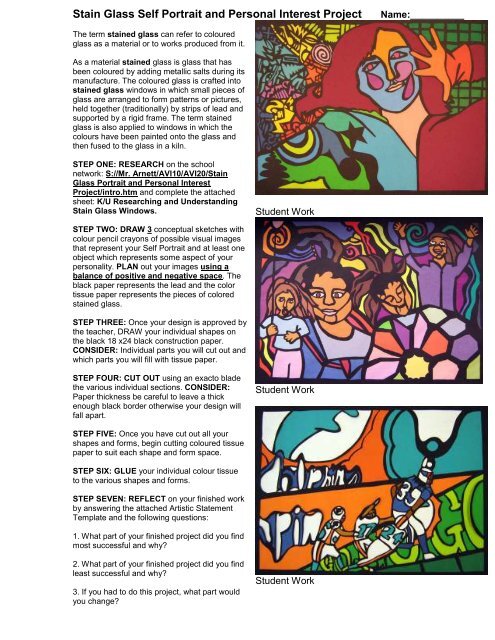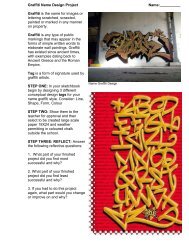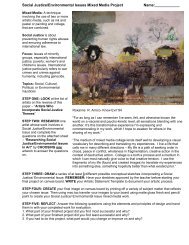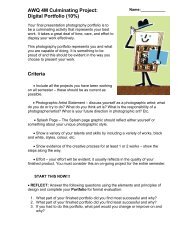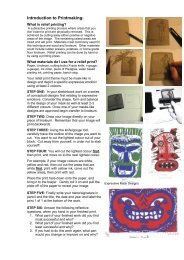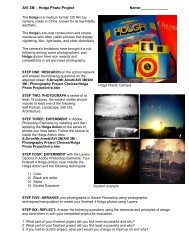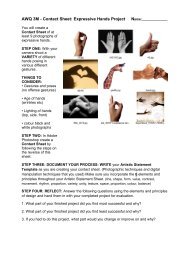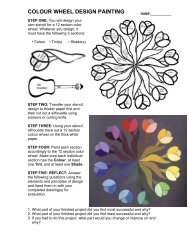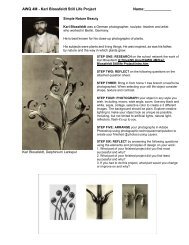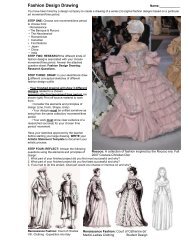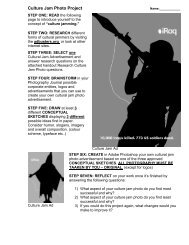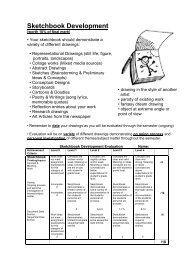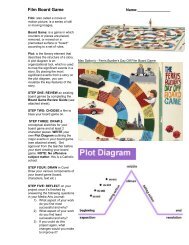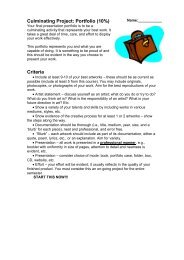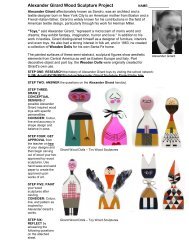Stain Glass Self Portrait and Personal Interest Project Name:______
Stain Glass Self Portrait and Personal Interest Project Name:______
Stain Glass Self Portrait and Personal Interest Project Name:______
Create successful ePaper yourself
Turn your PDF publications into a flip-book with our unique Google optimized e-Paper software.
<strong>Stain</strong> <strong>Glass</strong> <strong>Self</strong> <strong>Portrait</strong> <strong>and</strong> <strong>Personal</strong> <strong>Interest</strong> <strong>Project</strong> <strong>Name</strong>:__________<br />
The term stained glass can refer to coloured<br />
glass as a material or to works produced from it.<br />
As a material stained glass is glass that has<br />
been coloured by adding metallic salts during its<br />
manufacture. The coloured glass is crafted into<br />
stained glass windows in which small pieces of<br />
glass are arranged to form patterns or pictures,<br />
held together (traditionally) by strips of lead <strong>and</strong><br />
supported by a rigid frame. The term stained<br />
glass is also applied to windows in which the<br />
colours have been painted onto the glass <strong>and</strong><br />
then fused to the glass in a kiln.<br />
STEP ONE: RESEARCH on the school<br />
network: S://Mr. Arnett/AVI10/AVI20/<strong>Stain</strong><br />
<strong>Glass</strong> <strong>Portrait</strong> <strong>and</strong> <strong>Personal</strong> <strong>Interest</strong><br />
<strong>Project</strong>/intro.htm <strong>and</strong> complete the attached<br />
sheet: K/U Researching <strong>and</strong> Underst<strong>and</strong>ing<br />
<strong>Stain</strong> <strong>Glass</strong> Windows.<br />
STEP TWO: DRAW 3 conceptual sketches with<br />
colour pencil crayons of possible visual images<br />
that represent your <strong>Self</strong> <strong>Portrait</strong> <strong>and</strong> at least one<br />
object which represents some aspect of your<br />
personality. PLAN out your images using a<br />
balance of positive <strong>and</strong> negative space. The<br />
black paper represents the lead <strong>and</strong> the color<br />
tissue paper represents the pieces of colored<br />
stained glass.<br />
STEP THREE: Once your design is approved by<br />
the teacher, DRAW your individual shapes on<br />
the black 18 x24 black construction paper.<br />
CONSIDER: Individual parts you will cut out <strong>and</strong><br />
which parts you will fill with tissue paper.<br />
STEP FOUR: CUT OUT using an exacto blade<br />
the various individual sections. CONSIDER:<br />
Paper thickness be careful to leave a thick<br />
enough black border otherwise your design will<br />
fall apart.<br />
STEP FIVE: Once you have cut out all your<br />
shapes <strong>and</strong> forms, begin cutting coloured tissue<br />
paper to suit each shape <strong>and</strong> form space.<br />
STEP SIX: GLUE your individual colour tissue<br />
to the various shapes <strong>and</strong> forms.<br />
STEP SEVEN: REFLECT on your finished work<br />
by answering the attached Artistic Statement<br />
Template <strong>and</strong> the following questions:<br />
1. What part of your finished project did you find<br />
most successful <strong>and</strong> why?<br />
2. What part of your finished project did you find<br />
least successful <strong>and</strong> why?<br />
3. If you had to do this project, what part would<br />
you change?<br />
Student Work<br />
Student Work<br />
Student Work
K/U Researching <strong>and</strong> Underst<strong>and</strong>ing <strong>Stain</strong> <strong>Glass</strong> Windows <strong>Name</strong>:____________<br />
Select one work on the network <strong>and</strong> answer the following questions<br />
S://Mr. Arnett/AVI10/AVI20/<strong>Stain</strong> <strong>Glass</strong> <strong>Portrait</strong> <strong>and</strong> <strong>Personal</strong> <strong>Interest</strong> <strong>Project</strong>/intro.htm<br />
<strong>Name</strong> of Chosen Artwork:____________________<br />
DESCRIPTION<br />
1. Describe what kind of work it is: (1)<br />
Thumbnail sketch of<br />
chosen <strong>Stain</strong> <strong>Glass</strong><br />
work<br />
ANALYSIS<br />
1. Choose 6 elements <strong>and</strong> principles of design <strong>and</strong> analyze how they are used in the work:<br />
(line, shape, colour, form, movement, rhythm, contrast, texture, balance, variety, proportion, unity,<br />
emphasis, space) (6)<br />
1. -<br />
2. -<br />
3. -<br />
4. -<br />
5. -<br />
6. –<br />
INTERPRETATION<br />
1. Based on what you have learned about this artwork, what do you think the artist was trying to<br />
say? (1)<br />
2. What feeling does the artwork evoke in you? (1)<br />
JUDGEMENT<br />
1. Do you like this artwork? Why or why not? (Base your answers on what you have learned)<br />
Explain.(2)
Artistic Statement Template <strong>Name</strong>:____________<br />
Artwork Title:______________________________________________<br />
A) Influence(s) <strong>and</strong> research from past <strong>and</strong> present works: (Examples on school network:<br />
S://Mr. Arnett/AVI10/AVI20/<strong>Stain</strong> <strong>Glass</strong> <strong>Portrait</strong> <strong>and</strong> <strong>Personal</strong> <strong>Interest</strong> <strong>Project</strong>/intro.htm)<br />
B) Drawing/Sculpture/Assemblage techniques used in my work <strong>and</strong> how they<br />
support my intended visual message:<br />
C) REFLECTION: What do you consider to be the strength of your finished work?<br />
What do you consider to be the weakness of your finished work?<br />
What do you consider to be the next step of your finished work, if you were to do this<br />
project again?
<strong>Stain</strong> <strong>Glass</strong> <strong>Self</strong> <strong>Portrait</strong> <strong>and</strong> <strong>Personal</strong> <strong>Interest</strong> Rubric <strong>Name</strong>:_________<br />
Knowledge/<br />
Underst<strong>and</strong>ing<br />
Demonstrates<br />
underst<strong>and</strong>ing of the<br />
elements & principles<br />
of design in the <strong>Stain</strong><br />
glass imagery (e.g.<br />
line, shape, colour,<br />
unity)<br />
Thinking/<br />
Inquiry<br />
<strong>Stain</strong> <strong>Glass</strong> <strong>Self</strong><br />
<strong>Portrait</strong> & <strong>Personal</strong><br />
<strong>Interest</strong><br />
Communication<br />
Clarity:<br />
Discusses research &<br />
influences in the<br />
artistic statement<br />
Explains use of<br />
drawing/sculpture/ass<br />
emblage techniques<br />
in the artistic<br />
statement<br />
Reflective Questions:<br />
Strength, Weakness<br />
& Next Step<br />
Application<br />
Creative Process:<br />
Ability to solve a<br />
series of artistic<br />
problems, showing an<br />
awareness of formal<br />
qualities, visual<br />
conventions, <strong>and</strong><br />
relevant ideas <strong>and</strong><br />
concepts.<br />
Preliminary/Conceptu<br />
al Sketches (3)<br />
Creative Process:<br />
Demonstration of Skill<br />
Development &<br />
following procedures<br />
including Clean Up<br />
Uses elements &<br />
principles of design<br />
<strong>and</strong> drawing/<br />
sculpture/assemblage<br />
techniques to<br />
produce an effective<br />
artwork (e.g. shape,<br />
form, colour, unity)<br />
Size (18X24` ) &<br />
Balanced Design<br />
Level 0<br />
Work does not<br />
meet<br />
assignments<br />
expectations for<br />
this category.<br />
Incomplete.<br />
0<br />
Work does not<br />
meet<br />
assignments<br />
expectations for<br />
this category.<br />
Incomplete.<br />
0<br />
Work does not<br />
meet<br />
assignments<br />
expectations for<br />
this category.<br />
Incomplete.<br />
0<br />
Incomplete.<br />
0<br />
Incomplete.<br />
0<br />
Work does not<br />
meet<br />
assignments<br />
expectations for<br />
this category.<br />
Incomplete.<br />
0<br />
Incomplete.<br />
0<br />
Incomplete.<br />
0<br />
Incomplete.<br />
0<br />
Level 1<br />
Student<br />
demonstrates<br />
limited<br />
underst<strong>and</strong>ing of<br />
the elements &<br />
principles of design<br />
in the stain glass<br />
imagery.<br />
0.25<br />
Student depicts<br />
imagery in the<br />
stain glass material<br />
with limited<br />
effectiveness.<br />
0.25<br />
Student discusses<br />
influences in the<br />
artistic statement<br />
with limited clarity.<br />
0.25<br />
Student explains<br />
use of<br />
drawing/sculpture<br />
/assemblage<br />
techniques in the<br />
artistic statement<br />
with limited clarity.<br />
0.25<br />
Poor, yes/no<br />
answers/limited<br />
incomplete.<br />
0.25<br />
Preliminary<br />
sketches are<br />
poor/incomplete.<br />
Concepts are<br />
poor/incomplete.<br />
Planning is<br />
tentative or nonexistent.<br />
(0.5)<br />
0.5<br />
Student<br />
demonstrates<br />
limited<br />
effectiveness in<br />
demonstrating the<br />
creative process<br />
<strong>and</strong> following<br />
procedures.<br />
5<br />
Student<br />
demonstrates<br />
limited use of the<br />
elements &<br />
principles of design<br />
& drawing/<br />
sculpture/assemb<br />
lage techniques to<br />
produce an art<br />
work of limited<br />
effectiveness.<br />
1<br />
Work<br />
demonstrates<br />
limited/not<br />
balance <strong>and</strong> is<br />
incorrect size.<br />
(over 18x24”)<br />
1<br />
Level 2<br />
Student demonstrates<br />
some underst<strong>and</strong>ing<br />
of the elements &<br />
principles of design in<br />
the stain glass<br />
imagery.<br />
0.50<br />
Student depicts<br />
imagery in the stain<br />
glass material with<br />
some effectiveness.<br />
0.50<br />
Student discusses<br />
influences in the<br />
artistic statement with<br />
some clarity.<br />
0.50<br />
Student explains use<br />
of drawing/sculpture/<br />
assemblage<br />
techniques in the<br />
artistic statement with<br />
some clarity.<br />
0.50<br />
Somewhat coherent<br />
<strong>and</strong> somewhat<br />
complete.<br />
0.50<br />
Preliminary sketches<br />
are somewhat clear<br />
<strong>and</strong> complete.<br />
Concepts are<br />
somewhat complete.<br />
Planning is somewhat<br />
substantial & shows<br />
some alternative<br />
ideas. (1-2)<br />
1<br />
Student demonstrates<br />
some effectiveness in<br />
demonstrating the<br />
creative process <strong>and</strong><br />
following procedures.<br />
5-6<br />
Student demonstrates<br />
some use of the<br />
elements & principles<br />
of design & drawing/<br />
sculpture/assemblag<br />
e techniques to<br />
produce an art work<br />
of some<br />
effectiveness.<br />
2-3<br />
Work demonstrates<br />
adequate balance<br />
<strong>and</strong> is acceptable<br />
size. (18x24”)<br />
2-3<br />
Level 3<br />
Student demonstrates<br />
considerable<br />
underst<strong>and</strong>ing of the<br />
elements & principles<br />
of design in the stain<br />
glass imagery.<br />
0.75<br />
Student depicts<br />
imagery in the stain<br />
glass material with<br />
considerable<br />
effectiveness.<br />
0.75<br />
Student discusses<br />
influences in the<br />
artistic statement with<br />
considerable clarity.<br />
0.75<br />
Student explains use<br />
of drawing/sculpture/<br />
assemblage<br />
techniques in the<br />
artistic statement with<br />
considerable clarity.<br />
0.75<br />
Clear <strong>and</strong> substantial<br />
answers.<br />
0.75<br />
Preliminary sketches<br />
are mostly complete.<br />
Concepts are<br />
complete. Planning is<br />
evident & shows<br />
some divergent<br />
thinking is evident. (2-<br />
3)<br />
1-1.75<br />
Student demonstrates<br />
considerable<br />
effectiveness in<br />
demonstrating the<br />
creative process <strong>and</strong><br />
following procedures.<br />
7-8<br />
Student demonstrates<br />
considerable use of<br />
the elements &<br />
principles of design &<br />
drawing/sculpture/as<br />
semblage techniques<br />
to produce an art<br />
work of considerable<br />
effectiveness.<br />
3-4<br />
Work demonstrates<br />
considerable balance<br />
<strong>and</strong> is acceptable<br />
size. (18x24”)<br />
3-4<br />
Level 4<br />
Student<br />
demonstrates<br />
a high degree of<br />
underst<strong>and</strong>ing of<br />
the elements &<br />
principles of design<br />
in the stain glass<br />
imagery.<br />
1<br />
Student depicts<br />
imagery in the<br />
stain glass material<br />
with issue high<br />
degree of<br />
effectiveness.<br />
1<br />
Student discusses<br />
influences in the<br />
artistic statement<br />
with a high degree<br />
of clarity.<br />
1<br />
Student explains<br />
use of drawing/<br />
sculpture/assemb<br />
lage techniques in<br />
the artistic<br />
statement with a<br />
high degree of<br />
clarity.<br />
1<br />
Superior <strong>and</strong><br />
insightful answers.<br />
1<br />
Preliminary<br />
sketches are<br />
thorough &<br />
complete.<br />
Concepts are fully<br />
developed.<br />
Planning is<br />
exceptional &<br />
shows<br />
considerable<br />
flexibility in<br />
thinking. (3+)<br />
2<br />
Student<br />
demonstrates<br />
superior<br />
effectiveness in<br />
demonstrating the<br />
creative process<br />
<strong>and</strong> following<br />
procedures.<br />
8- 10<br />
Student<br />
demonstrates a<br />
high degree of<br />
using the elements<br />
& principles of<br />
design & drawing/<br />
sculpture/assemb<br />
lage techniques to<br />
produce a highly<br />
effective art work.<br />
5<br />
Work<br />
demonstrates<br />
superior balance<br />
<strong>and</strong> is acceptable<br />
size. (18x24”)<br />
5<br />
/1<br />
/1<br />
/1<br />
/1<br />
/1<br />
/2<br />
/10<br />
/5<br />
/5<br />
/27
A1. The Creative Process: apply the creative process to create a variety of art works, individually <strong>and</strong>/or collaboratively;<br />
A1.1 use a variety of strategies, individually <strong>and</strong>/or collaboratively, to generate ideas <strong>and</strong> to develop plans for the creation of art works<br />
(e.g., use research, synectic charts, <strong>and</strong>/or a class brainstorming session to generate a variety of creative ideas; reflect on the suitability of<br />
the ideas <strong>and</strong> choose one to serve as the basis for their plan; use notes <strong>and</strong>/or thumbnail sketches to develop their plans; revise their<br />
plans on the basis of peer- <strong>and</strong> self-assessment)<br />
A1.2 use exploration/experimentation, reflection, <strong>and</strong> revision when producing a variety of art works in each of the following areas:<br />
drawing, sculpture, painting, <strong>and</strong> printmaking (e.g., explore a variety of materials <strong>and</strong>/or techniques; reflect on the input of their peers;<br />
refine their art work on the basis of useful feedback)<br />
A1.3 document their use of the creative process in a portfolio (e.g., include thumbnail sketches of ideas <strong>and</strong>/or plans, notes on or<br />
examples of the results of experiments with different media or techniques, <strong>and</strong> copies of their preliminary <strong>and</strong> final work to<br />
show evidence of revision <strong>and</strong> artistic growth), <strong>and</strong> refer to this portfolio to reflect on how effectively they have used the creative process<br />
A2. The Elements <strong>and</strong> Principles of Design: apply elements <strong>and</strong> principles of design to create art works for the purpose of self-expression <strong>and</strong> to<br />
communicate ideas, information, <strong>and</strong>/or messages;<br />
A2.1 explore elements <strong>and</strong> principles of design, <strong>and</strong> apply them to create art works that express personal feelings <strong>and</strong>/or communicate<br />
emotions to an audience (e.g., explore the use of colour, texture, <strong>and</strong>/or space to express specific emotions)<br />
A2.2 apply elements <strong>and</strong> principles of design to create art works that communicate ideas <strong>and</strong> information<br />
A3. Production <strong>and</strong> Presentation: produce art works, using a variety of media/materials <strong>and</strong> traditional <strong>and</strong>/or emerging technologies, tools, <strong>and</strong><br />
techniques, <strong>and</strong> demonstrate an underst<strong>and</strong>ing of a variety of ways of presenting their works <strong>and</strong> the works of others.<br />
A3.1 explore <strong>and</strong> experiment with a variety of media/materials <strong>and</strong> traditional <strong>and</strong>/or emerging technologies, tools, <strong>and</strong> techniques, <strong>and</strong><br />
apply them to produce art works<br />
A3.3 demonstrate an underst<strong>and</strong>ing of some of the ways in which art works can be presented to reach a variety of audiences<br />
B1. The Critical Analysis Process: demonstrate an underst<strong>and</strong>ing of the critical analysis process by examining, interpreting, evaluating, <strong>and</strong> reflecting<br />
on various art works;<br />
B1.4 use a variety of strategies (e.g., peer- <strong>and</strong> self-assessment, formal <strong>and</strong> informal critiques, small-group <strong>and</strong> class discussions) to<br />
identify <strong>and</strong> reflect on the qualities of their own art works <strong>and</strong> the works of others, <strong>and</strong> evaluate the effectiveness of these works<br />
B2. Art, Society, <strong>and</strong> Values: demonstrate an underst<strong>and</strong>ing of how art works reflect the societies in which they were created, <strong>and</strong> how they can<br />
affect personal values;<br />
B2.3 identify ways in which creating <strong>and</strong>/or analysing art works has affected their personal identity <strong>and</strong> values<br />
C1. Terminology: demonstrate an underst<strong>and</strong>ing of, <strong>and</strong> use correct terminology when referring to, elements, principles, <strong>and</strong> other components<br />
related to visual arts;<br />
C1.1 use appropriate terminology when identifying <strong>and</strong> describing the use of elements <strong>and</strong> principles of design in their own art works <strong>and</strong><br />
the works of others<br />
C1.2 use appropriate vocabulary to describe techniques, materials, <strong>and</strong> tools when creating <strong>and</strong> presenting visual art works (e.g., brayers,<br />
conté, frottage, markers, painting techniques, pencil techniques, relief, stencil)<br />
C1.3 identify the stages of the creative process <strong>and</strong> the critical analysis process using appropriate terminology<br />
C2. Conventions <strong>and</strong> Techniques: demonstrate an underst<strong>and</strong>ing of conventions <strong>and</strong> techniques used in the creation of visual art works;<br />
C2.1 demonstrate an underst<strong>and</strong>ing of some techniques that artists use to achieve specific effects<br />
C3. Responsible Practices: demonstrate an underst<strong>and</strong>ing of responsible practices in visual arts.<br />
C3.2 demonstrate safe <strong>and</strong> conscientious practices associated with the use of materials, tools, <strong>and</strong> technologies in visual arts (e.g.,<br />
identify hazardous materials <strong>and</strong> adopt appropriate precautions <strong>and</strong>/or protective measures when using them; demonstrate<br />
respect for property, including classroom facilities, tools, equipment, <strong>and</strong> technological devices)


